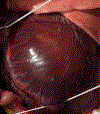Canine Model of Ischemia-Induced Ventricular Tachycardia
- PMID: 37778087
- PMCID: PMC10840854
- DOI: 10.1016/j.jss.2023.09.003
Canine Model of Ischemia-Induced Ventricular Tachycardia
Abstract
Introduction: Despite advances in antiarrhythmia therapies, ventricular tachycardia (VT) is a leading cause of sudden cardiac death. Investigation into the characteristics and new treatments for this arrhythmia is required to improve outcomes and a reproducible model of VT would be useful in these endeavors. We therefore created a canine model of ischemia-induced VT.
Materials and methods: A pacing lead was implanted in the right ventricle in canines (n = 13) and the left anterior descending artery was occluded in two locations for 2 h and subsequently released to create an ischemia-reperfusion injury. In the 10 dogs that survived the first 48 h following the initial study, a terminal study was conducted 4-7 d later and VT was induced using premature stimulation or burst pacing through the right ventricle lead. The arrhythmia was terminated using either antitachycardia pacing or a defibrillatory shock. Multiple inductions into sustained VT were attempted.
Results: Sustained VT was induced in eight of 10 dogs with an average cycle length of 335 ± 70 bpm. Multiple episodes of VT were induced. Episodes of VT exhibited different electrocardiogram morphologies and cycle lengths in individual animals.
Conclusions: This canine model provides a consistent technique for inducing multiple episodes of sustained VT. It may be useful for investigating VT mechanisms and testing novel therapeutics and treatments for patients with VT.
Keywords: Canine model; Ischemia-reperfusion; Ventricular tachycardia.
Copyright © 2023 Elsevier Inc. All rights reserved.
Figures




References
Publication types
MeSH terms
Grants and funding
LinkOut - more resources
Full Text Sources

